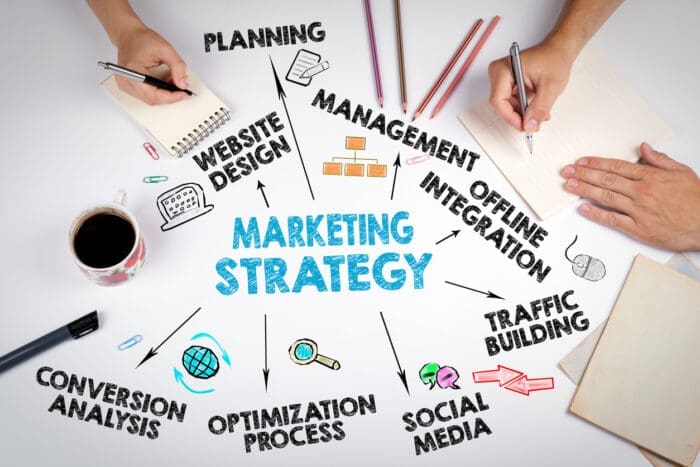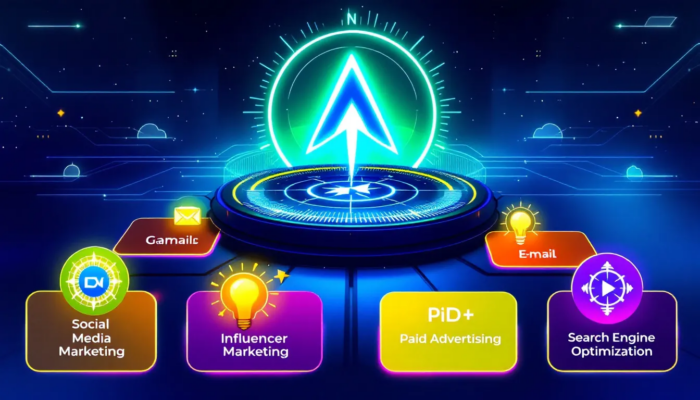Are you looking to align your marketing efforts with your business goals? A strategic marketing plan is your roadmap. This article will guide you through creating an effective plan step by step, from understanding key components to setting measurable objectives.
Key Takeaways
- Strategic marketing planning aligns marketing efforts with business objectives, ensuring efficient use of resources and measurable outcomes.
- Critical components of a strategic marketing plan include a mission statement, SWOT analysis, clear goals, and performance metrics (KPIs) for evaluation.
- Thorough market research and target audience identification are essential for developing effective marketing strategies and achieving business success.
Understanding Strategic Marketing Planning

Strategic marketing planning is foundational to any successful business strategy. It involves creating a detailed marketing strategy outline that aligns with overall business objectives and delivers measurable results. Think of it as the blueprint that guides your marketing activities toward achieving specific goals, whether it’s increasing brand awareness, generating leads, or driving sales. This marketing strategy covers all aspects necessary for success.
This process helps organizations identify opportunities, anticipate challenges, and develop targeted strategies that capitalize on market trends. Aligning marketing efforts with business objectives streamlines resource allocation and optimizes marketing investments. The result? A more efficient and effective marketing strategy that stands out in a crowded media landscape.
Key Components of a Strategic Marketing Plan

A comprehensive strategic marketing plan includes several key components working together to achieve objectives. Central to this is the mission statement, defining how your strategy supports business objectives and guides marketing efforts. This mission statement should be aligned with your broader business goals and reflect your company’s core values.
Another essential component is the SWOT analysis, assessing current marketing efforts by identifying strengths, weaknesses, opportunities, and threats. Clear goals and objectives guide efforts and evaluate effectiveness.
Additionally, key performance indicators (KPIs) are vital for tracking the success of your marketing activities and making informed adjustments to your strategies.
The Strategic Marketing Planning Process
Creating a strategic marketing plan is a detailed process that begins with defining your goals. Goals should be specific, measurable, achievable, relevant, and time-bound (SMART), providing clear direction for your efforts. After setting goals, conduct thorough market research to understand your position and identify growth opportunities.
You can start formulating your marketing strategies with a solid understanding of your offerings and audience. This involves breaking down your annual goals into smaller, manageable objectives and creating a timeline that outlines the tactics and deadlines for each marketing activity. The more detailed your plan, the better your chances of success, as it helps stakeholders understand the expectations and milestones.
Finally, create a comprehensive roadmap to guide your efforts toward achieving defined goals. This should include realistic goals, sound information, and community research to ensure well-informed and effective strategies. This structured approach can optimize your marketing investments and improve your overall performance.
Conducting Market Research

Market research forms the backbone of any strategic marketing plan. It helps understand market trends, consumer behavior, and the competitive landscape, allowing tailored marketing efforts. Market research involves gathering data through various methods such as surveys, interviews, and direct conversations with your audience. This data-driven approach enables you to make informed decisions and identify gaps in the market.
Accurate customer data helps you understand your target audience’s demographics, preferences, and needs. Analyzing this data aids in predicting evolving expectations and developing strategies that address unmet needs and improve satisfaction. Regular market research and customer feedback are crucial for identifying new opportunities and adapting to changing market conditions.
Setting Marketing Objectives
Setting clear marketing objectives is critical in the strategic planning process. Objectives must be SMART: Specific, Measurable, Achievable, Relevant, and Time-bound. For example, a measurable marketing goal could be to increase new customer acquisition by 5% in six months and 10% by the end of the year. Such goals provide clear direction and help track progress effectively.
Marketing objectives should align with broader business goals and contribute meaningfully to your company’s mission, offering a clear path for your efforts. Setting realistic and measurable goals ensures that your marketing strategies are focused, effective, and capable of driving business growth.
Identifying Your Target Audience
Identifying your target audience is vital for creating relevant and impactful marketing strategies. This involves analyzing demographic and psychographic data to understand characteristics, preferences, and needs. Thorough market research can help you identify your target audience and tailor your marketing efforts.
Creating buyer personas is a powerful tool for visualizing and understanding ideal customers. Based on research, these fictional representations help tailor marketing efforts to address the unique preferences and motivations of different segments.
Effective buyer persona research combines insights from existing customers with broader consumer research to form detailed market segmentation.
Developing a Value Proposition
A strong value proposition is crucial for differentiating your product or service in a competitive market. It is a concise statement that explains why customers should choose your product or service over others. Crafting a compelling value proposition involves understanding customer needs, addressing pain points, and highlighting how your offerings provide solutions.
Key components of a strong value proposition include identifying your target audience, articulating your brand promise, and detailing the benefits offered. Utilizing a value proposition canvas can help align your business offerings with customer expectations and needs.
By establishing internal alignment among team members on essential benefits, you can craft an accurate and compelling value proposition that resonates with your audience and contributes to a sustainable competitive advantage.
Selecting Marketing Channels

Choosing the right marketing channels is vital for reaching and engaging your target audience. This decision should be based on thorough audience analysis to ensure alignment with where your audience engages. The chosen channels must reflect and enhance your brand’s identity and values.
Well-planned budgeting is essential for identifying which marketing strategies will effectively reach your audience. It’s also important to evaluate the cost-effectiveness of each marketing channel to ensure financial feasibility. A multi-channel approach can help businesses avoid over-reliance on a single channel, reducing risk and increasing the chances of reaching a broader audience.
Creating a Marketing Budget
Creating a marketing budget is essential in the strategic planning process. It allows efficient resource allocation to initiatives that contribute most effectively to success. Establishing a budget based on financial capabilities ensures campaigns remain within financial limits.
Allocating a percentage of revenue to marketing can vary based on a company’s growth stage and industry. Start small and focus on one or two efforts before expanding. When allocating resources in a marketing budget, it’s vital to consider the potential return on investment (ROI). This consideration can greatly influence decision-making.
Customer acquisition cost (CAC) and return on investment (ROI) are key metrics that provide insights into initiative profitability and help prioritize successful strategies.
Launching Marketing Campaigns

Launching a marketing campaign involves several steps, beginning with a structured campaign calendar to maintain focus and ensure timely execution. An effective promotion strategy requires deep knowledge of the product, value, and price point. Incorporate various channels for customer communication to maximize reach and engagement.
Monitoring the campaign’s performance during its execution is essential for measuring its effectiveness against the set goals. Key performance indicators (KPIs) such as organic traffic, bounce rate, and conversions provide valuable insights into the campaign’s success.
After the campaign ends, analyzing its results helps determine what worked and what can be improved for future campaigns.
Measuring Marketing Performance
Measuring marketing performance is essential for understanding what works and making data-driven decisions. Key Performance Indicators (KPIs) are crucial for monitoring performance and informing strategy adjustments. Common KPIs in marketing include website traffic, conversion rates, sales revenue, and customer feedback.
Regular evaluation of marketing efforts is necessary to determine their effectiveness and make adjustments. You can track and analyze performance effectively by assigning metrics to each marketing tactic.
Data from KPIs provides precise direction for improving campaigns and identifying areas needing improvement.
Adapting to Market Changes
In an ever-evolving business landscape, continuous evaluation and refinement of strategies are crucial for adapting to market dynamics. Research and customer feedback are essential for refining strategies over time. Tracking intermediate metrics helps identify where potential customers might face obstacles in the marketing funnel.
Setting aside a portion of the budget for unforeseen opportunities is vital for adaptability. Businesses should prepare for future industry changes and opportunities, ensuring they remain competitive and responsive to trends.
Leveraging Content Marketing
Content marketing is pivotal in engaging the target audience and building brand loyalty. Blogging is one of the most proven content marketing techniques. User-generated content (UGC) is another powerful tool, as it is created by customers promoting your products. UGC helps build community and encourages product promotion.
Different types of content, such as short-form videos, influencer marketing, and social media DMs, are emphasized for high visibility. B2B companies can utilize user-generated content by sharing positive reviews, enhancing their strategy, and building trust.
Integrating Digital Marketing
Integrating SEO into your digital marketing approach enhances online visibility and drives traffic without additional costs. A cohesive SEO strategy aligns your website, content, social media, and paid campaigns to optimize search engine performance. This integration not only improves user experience but also boosts search engine rankings.
Using the same keywords in both SEO and PPC strategies improves performance across both channels. Local SEO optimizes your online presence to attract business from relevant local searches, ensuring you reach your target market effectively.
Case Studies and Examples
Real-world examples significantly enhance understanding of how strategic marketing plans can be effectively implemented and the outcomes they generate. For instance, Red Bull’s ‘Stratos’ space jump campaign exemplified extreme branding, aligning the brand with high-energy events and creating a global spectacle. This campaign profoundly impacted brand perception, showcasing the effectiveness of aligning marketing strategies with emotional and experiential consumer engagement.
Similarly, Procter & Gamble’s ‘Thank You, Mom’ campaign connected emotionally with audiences by highlighting mothers’ roles in supporting athletes and enhancing brand loyalty.
These case studies demonstrate how well-crafted marketing campaigns can drive significant results and strengthen brand identity.
Summary
In summary, crafting a winning strategic marketing plan involves understanding its core components, conducting thorough market research, setting clear objectives, and selecting the right marketing channels. By developing a solid value proposition and creating a well-structured marketing budget, you can ensure your efforts are focused and effective. Launching and monitoring marketing campaigns, measuring performance, and adapting to market changes are essential for continuous improvement and long-term success.
By leveraging content marketing and integrating digital marketing strategies, you can enhance your online presence and engage your target audience more effectively. Real-world examples provide valuable insights into the impact of strategic marketing plans. It’s time to apply these insights to create your winning marketing strategy.

Frequently Asked Questions About a Strategic Marketing Plan
What is the purpose of a strategic marketing plan?
A strategic marketing plan aims to create a structured approach that aligns marketing objectives with overall business strategies, ensuring optimized investments and better outcomes. This focused roadmap is essential for achieving sustainable growth.
How do you conduct effective market research?
Effective market research requires various methods to gather valuable insights, such as surveys, interviews, and direct conversations with your target audience. This approach enables data-driven decisions and helps identify market gaps.
What are SMART marketing objectives?
SMART marketing objectives are clearly defined goals that are Specific, Measurable, Achievable, Relevant, and Time-bound. They enable effective tracking and focused direction in your marketing strategies. By using this framework, you can enhance your marketing efforts and ensure accountability.
Why is identifying your target audience important?
Identifying your target audience is crucial because it enables you to develop tailored marketing strategies that resonate with their preferences and motivations. This ultimately enhances the effectiveness of your campaigns. Understanding your audience ensures that your efforts yield maximum impact.
How can content marketing benefit your marketing strategy?
Content marketing effectively engages your target audience and fosters brand loyalty through strategies like blogging and user-generated content. This approach increases engagement and builds a strong community around your brand.

Ready to Create a Strategic Marketing Plan?
Building a successful marketing plan is the first step toward achieving remarkable growth. Let’s make it happen together with strategies designed to elevate your brand.
Get Started with Your Strategic Marketing Plan!
- Dive Deeper into Strategic Marketing
Explore more resources to enhance your planning skills and drive results. - Craft Your Winning Strategy
Need help creating a plan that aligns with your business goals? Our experts are here to guide you every step of the way. Contact us for personalized advice. - Schedule a Free Strategy Consultation
Let’s discuss how a strategic marketing plan can accelerate your business growth. Book a consultation with our team.
About the author
Mark A. Hope is the co-founder and Partner at Asymmetric Marketing, an innovative agency dedicated to creating high-performance sales and marketing systems, campaigns, processes, and strategies tailored for small businesses. With extensive experience spanning various industries, Asymmetric Marketing excels in delivering customized solutions that drive growth and success. If you’re looking to implement the strategies discussed in this article or need expert guidance on enhancing your marketing efforts, Mark is here to help. Contact him at 608-410-4450 or via email at mark.hope@asymmetric.pro.

